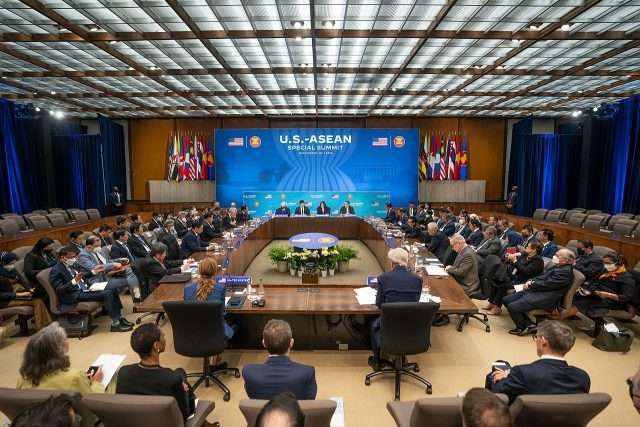
Geopolitical Report ISSN 2785-2598 Volume 19 Issue 14
Author: Riccardo Rossi
On May 12th – 13th, 2022, President Biden held a summit in Washington with the member states of the Association of Southeast Asian Nations (ASEAN) [1] to counter the political-economic expansionism of the People’s Republic of China (PRC) in the Asia-Pacific region.[2]
Geopolitical Scenario
President Biden’s decision to hold a summit with ASEAN in Washington is part of a comprehensive U.S. strategy for the Asia-Pacific called Pivot to Asia to counter the PRC’s growing economic-military assertiveness in the China Sea and South-East Asia region. [3]
Concerning the China Sea, the United States considers the concentration of resources of the People’s Liberation Army (PLA) near the Korean peninsula, the island of Formosa, the Spratly and Paracelsus archipelagos, and the Taiwan, Luzon, Miyako, and Malacca straits to be a danger to the geopolitical stability of the region.[4] According to Washington’s geostrategic perspective, the objective of this Chinese militarisation programme is to impose its sea control around Taiwan, Luzon, Miyako and Malacca because they are obligatory passages of the Sea Lines of Communications (SLOCs) that interconnect the PRC’s major ports with the Pacific Ocean, Sea of Japan and Bay of Bengal trade routes.[5]
In the case of South-East Asia, President Biden considers Beijing’s political-economic will to use the hydroelectric network built in its transboundary rivers (Mekong Salween) as a tool to meet part of the national energy needs and to regulate the Mekong’s water flow by conditioning the river economies of the five South-East Asian countries crossed by this emissary: Burma, Laos, Thailand, Cambodia and Vietnam.
Beijing’s establishment confirms this U.S. consideration in 2016 of the Lancang-Mekong Cooperation (LMC), an organisation that includes the six countries crossed by the Mekong River (China, Cambodia, Laos, Myanmar, Thailand and Vietnam). Through this association, Beijing has an effective coercive tool to influence economic and diplomatic decisions and the choice of alliances that a country or group of states in the region might undertake.[6]
Risk Assessment
The assertive posture held by President Xi Jinping in the Asia-Pacific has led the United States to strengthen its Pivot to Asia policy, combining a strategy of military containment with strengthening its diplomatic and trade relations with countries in the region.
About the latter, the Biden administration’s decision to organise the summit with the ASEAN countries in Washington DC represents an opportunity and a tool to contain and reduce Beijing’s economic influence on the South-East Asian states and more effectively protect American commercial and financial interests in this area.
The countries of South-East Asia are, in fact, the fourth largest market in the world for Washington, with 360 billion dollars of foreign direct investment (FDI) by U.S. companies in 2020.[7] Because of the economic centrality of ASEAN,[8] the Biden chairmanship at the summit planned to allocate about 800 million dollars in bilateral assistance with ASEAN countries next year and about 25 million dollars to deepen relations with the South-East Asian association in specific areas: infrastructure-energy, trade and health and education.
Through this type of manoeuvre, Washington wants to reduce the economic dependence of South-East Asian countries on Chinese investment policies and favour the U.S. FDI multinationals toward the economies of this region, thereby increasing its influence.
Sources
[1] The Association of Southeast Asian Nations (ASEAN) was founded in Bangkok in 1967 and consisted of the following countries: Indonesia, Malaysia, Philippines, Singapore, Thailand, Brunei, Vietnam, Burma, Laos and Cambodia. ASEAN is a supranational organisation to promote economic cooperation and assistance among its member states.
[2]The White House Fact sheet: U.S.-ASEAN special summit in Washington, DC. Retrieved from: https://www.whitehouse.gov/briefing-room/statements-releases/2022/05/12/fact-sheet-u-s-asean-special-summit-in-washington-dc/
[3]Riccardo Rossi,(2022) Japan in the U.S. Pivot to Asia Policy, Geopolitical Report ISSN 2785-2598, Vol. 17(1), SpecialEurasia. Retrieved from: https://www.specialeurasia.com/it/2022/03/01/japan-united-states-asia/
[4] Bouchat. C (2017) U.S. landpower in the South China, U.S. Army War College Press, Carlisle Barracks, PA.
[5] Edmund J. Burke, Timothy R. Heath, Jeffrey W. Hornung, Logan Ma, Lyle J. Morris, Michael S. Chase (2018) China’s Military Activities in the East China Sea Implications for Japan’s Air Self-Defense Force, RAND Corporation, Santa Monica, California.
[6] Grünwald. R (2020) Lancang-Mekong Cooperation: Present and Future of the Mekong River Basin, In Politické vedy. Retrieved from: https://doi.org/10.24040/politickevedy.2020.23.2.69-97
[7] The White House Fact sheet: U.S.-ASEAN special summit in Washington, DC. Retrieved from: https://www.whitehouse.gov/briefing-room/statements-releases/2022/05/12/fact-sheet-u-s-asean-special-summit-in-washington-dc/
[8] The ASEAN Free Trade Area represents the third-largest market area in the world after the EU and NAFTA. It has a population of about 651 million, a GDP of 3000 billion and a per capita GDP of 4600 $ (FMI 2018).



